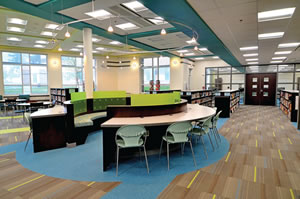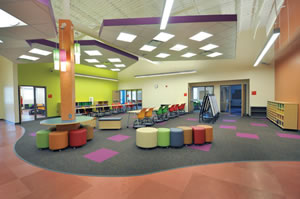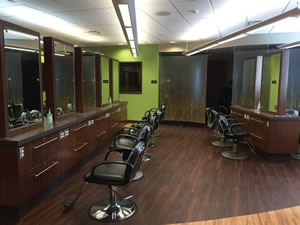Higher Marks for School Floors

PHOTOS COURTESY OF FANNING HOWEY
When facility managers fall asleep at night,
they dream of a flooring system that requires minimal
maintenance, lasts the life of the building and fits within
their limited budgets. In reality, there is no such perfect system.
However, new advances in flooring products like Luxury Vinyl Tile
(LVT) and carpet tile give educational facility owners the closest
thing to a dream product: relatively-inexpensive flooring systems
that require little long-term maintenance and, as an added bonus,
are friendly to the environment.
Luxury Performance on Limited Budgets
The name Luxury Vinyl Tile is a misnomer, as this increasingly
popular flooring product is actually affordable, especially when taking
into account total life-cycle costs. For years, Vinyl Composition
Tile (VCT) and Enhanced Tile (ET) products have dominated the
educational market, primarily due to their low initial cost. However,
educational facility owners who choose VCT or ET are forced to put
up with extensive maintenance regimens and relatively short life
cycles. Unlike VCT, LVT floors are pre-finished at the factory. This reduces
the need for maintenance staff to strip and re-wax the floor on
an annual basis. LVT is also much more durable than VCT, giving the
floor a longer life span. The extra cost associated with the purchase
of LVT flooring is more than offset by the reduced maintenance costs
over the life of the system. While LVT is about $2.50 a square foot
more expensive to purchase and install, it gives owners an $8.65 a
square foot cost savings compared to VCT over a 10-year life-cycle.

PHOTOS COURTESY OF FANNING HOWEY
Defining Space. Strategic transitions between tile flooring and carpet are
a good way to create small learning environments within a larger space.
In addition to the long-term cost savings, LVT floors provide
exceptional aesthetic flexibility. LVT products are available in
a variety of looks, including wood flooring, stained concrete or
carpet tile-like patterns. The durable nature of LVT makes it an
especially good choice for school cafeterias and other high-traffic
spaces, while the product’s wide range of patterns allows designers
to provide that extra visual oomph in spaces that can sometimes
have an institutional feel. But LVT is not just a good choice for
high-use spaces. The different texture options provide owners
with an effective way to separate quiet areas from louder areas and small learning environments from large collaboration spaces.
While LVT represents a fairly new product in the school market,
the evolution of an old standby, carpet, is also offering owners
exceptional value.
The Case for Carpet
The benefits of carpet tile are well documented. No flooring
product is easier to maintain. There is no need to worry about
stripping wax, microbial growth or scratched floors from furniture.
But new advancements in carpet tile are making the product
an even better option for educational facility owners.

PHOTOS COURTESY OF FANNING HOWEY
Durable and Attractive. LVT flooring provides the look of a wood
flooring system with reasonable first costs and minimal maintenance costs.
For carpet tile installation, some innovative new products
eliminate the need for a fully adhered, full caustic adhesive spread.
Instead, design and construction teams are able to take advantage of a
“floating floor” approach with less adhesive spread. This strategy uses
less adhesive product and allows installation of the carpet tile on a wet
slab with high moisture content. These sustainable, environmentally friendly
adhesives are cost effective and allow construction teams to
meet tight construction schedules and strict installation timeframes.
As school environments have evolved to a more open concept
in recent years, carpet tile has also changed. For the longest time,
carpet tile sizes were relegated to the traditional 24 inches x 24 inches
dimension. But manufacturers are now introducing carpet tile in
hexagonal tile shapes, plank shapes (9 inches x 36 inches, 6 inches x
48 inches, etc.) and even broadloom carpet with cushioned-resilient
backing for comfort and acoustic control. Working with a more diverse
pallete of options, design teams are able to provide better visual
differentiation among learning environments in large, open spaces.
Getting Sustainable
Sustainability is a large focus in the ever-changing flooring industry,
and there are some basic best practices from which every owner
can benefit. For example, old methods of maintenance have become
somewhat obsolete with the introduction of resilient flooring products
that come premanufactured with a final finish coat (rather than owner
waxing), have higher recycled content materials and promote a more
healthy and energy-efficient facility. However, every flooring manufacturer
has their green story to tell, and it is important to evaluate each
product individually to identify the solutions that will truly make an
impact on learning and the bottom line. Make sure that your designer
obtains proper documentation from each manufacturer. This will aid
in deciding which claims are greenwash and which are value-driven.
For educational facility owners looking to combine pragmatism
with environmentalism, there
are good options currently
available. First, try to focus on
using products that are able
to be recycled after the end
of their normal life. Several
popular flooring options can be
repurposed into high-recycled
content carpet tile or resilient
flooring. Next, consider using
products from manufacturers
that have a smaller carbon footprint.
Several smaller flooring manufacturers offer quality products,
without the infrastructure of large corporate, mass producing companies.
Finally, don’t forget about that venerable option, terrazzo.
Terrazzo is seeing a resurgence in use, as many owners are making
a bigger up-front investment to gain a virtually maintenance-free
floor that will last the life of any building.
Having it All
Flooring is often the place where educational facility owners are
quickest to compromise. Yet with new products like LVT and new
advances in carpet tile, this does not need to be the case. Today,
cost-conscious owners are still able to reduce long-term maintenance
expenses and create environmentally friendly buildings that
promote student health and wellness. The answer is closer than
you think. In fact, it is right under your feet.
This article originally appeared in the issue of .